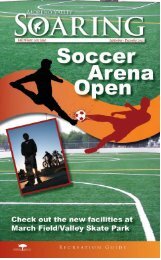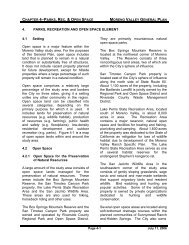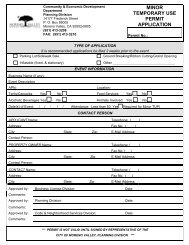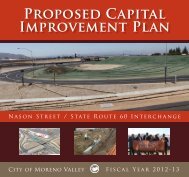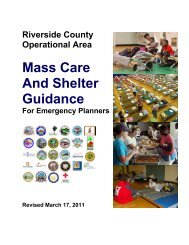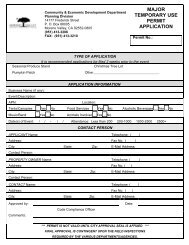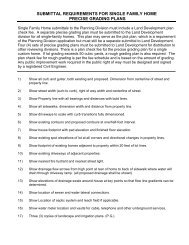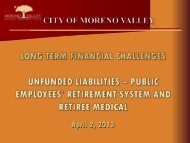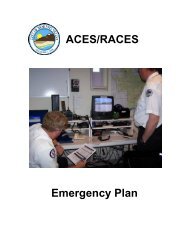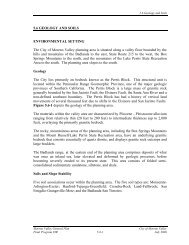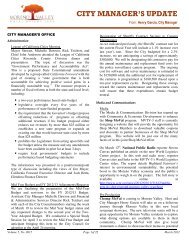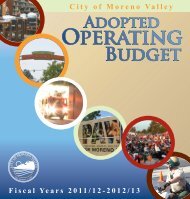General Plan - Moreno Valley
General Plan - Moreno Valley
General Plan - Moreno Valley
Create successful ePaper yourself
Turn your PDF publications into a flip-book with our unique Google optimized e-Paper software.
CHAPTER 7 - CONSERVATIONwas listed as a threatened federal speciesin 1993.The least bells vireo is an insectivorous birdlisted as a state and federal endangeredspecies. It is a summer resident of denseriparian habitats in Central and SouthernCalifornia and thought to winter in Mexico.Riparian portions of San Timoteo Canyon inthe northeastern corner of the study areaare considered suitable habitat for the leastbells vireo.7.1.2 Issues and OpportunitiesFuture urban development will result in theloss of natural vegetation and wildlifehabitats as development spreads over thevalley floor and into the surrounding hills.The vegetative and wildlife communitiespresent in the hillside areas will be impactedto the extent that development occurs in thehillsides.Riparian vegetation along drainage wayswill also be impacted as existing floodcontrol plans are implemented, and naturaldrainage courses are replaced with manmadefeatures. While it may be possible topreserve some drainage courses in anatural condition, it will require revisions toexisting master drainage plans andmaintenance mechanisms.The listing of threatened and endangeredspecies in western Riverside Countyprompted the private sector and publicagencies to work together toward a longtermsolution to wildlife conservation.Riverside County assumed the lead role inthe effort to develop a Multi-Species HabitatConservation <strong>Plan</strong> (MSHCP) for westernRiverside County, which was approved in2003. The MSHCP is a comprehensive,multi-jurisdictional effort that includes theCounty and fourteen cities. Rather thandeal with endangered species on a one-byonebasis, this <strong>Plan</strong> focuses on theconservation of 146 species. The MSHCPconsists of a reserve system ofMORENO VALLEY GENERAL PLANapproximately 500,000 acres of whichapproximately 347,000 acres were publicownership and 153,000 acres was in privateownership. The MSHCP provideslandowners, developers, and those whobuild public infrastructure with certainty, astreamlined regulatory process, andidentified project mitigation.7.2 CULTURAL AND HISTORICALRESOURCES7.2.1 BackgroundAncestors of the Luiseno and CahuillaIndian tribes were the first inhabitants of<strong>Moreno</strong> <strong>Valley</strong>. They hunted game andgathered seeds and plants. They leftevidence in rocks that they used to grindseeds. They also left primitive rockpaintings.Early settlers traveled through the area fromnorthern Mexico to various missionsettlements along a trail charted in 1774 byJuan Bautista de Anza. The trail passedthrough the San Jacinto <strong>Valley</strong>, the Perris<strong>Valley</strong> and southwest <strong>Moreno</strong> <strong>Valley</strong>.<strong>Moreno</strong> <strong>Valley</strong> and the rest of Californiabecame part of the United States in 1850.John Butterfield operated a stagecoach linebetween Tucson, San Diego, Los Angelesand San Francisco. A separate stage linewent through <strong>Moreno</strong> <strong>Valley</strong> from Perris<strong>Valley</strong> to Pigeon Pass and Reche Canyon.An irrigation district was formed in 1891 forthe purpose of importing water from areservoir in the San Bernardino Mountains.Most of the valley was subdivided and twotown sites were established in anticipation ofthe new water supply. The town of <strong>Moreno</strong>was established at the intersection ofAlessandro and Redlands Boulevards.Alessandro was located along the SouthernCalifornia Railway line at the intersection ofIris Avenue and Elsworth Street.Page 7-3 July 11, 2006



